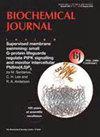Characterisation of an allosteric site in PLCγ enzymes and implications for development of their specific inhibitors.
IF 4.3
3区 生物学
Q2 BIOCHEMISTRY & MOLECULAR BIOLOGY
引用次数: 0
Abstract
PLCγ enzymes are key components of intracellular signal transduction processes and are involved in disease development, including immune dysregulation, specific cancer types, and neurodegeneration. Although recognised as important targets for intervention, validated pharmacological tools are lacking. Here, we demonstrate that inhibitory nucleotides bind directly to an allosteric site at the interface between the PLC-core and regulatory-array unique for PLCγ, underlying their specificity for the PLCγ family. This binding site overlaps with the PLCγ autoinhibitory interface, suggesting that the inhibitory impact of nucleotides involves stabilization of autoinhibition. We have also analysed disease-linked variants of PLCγ1 and PLCγ2 to show that multiple mechanisms could underpin their gain-of-function phenotype. While sensitivity of these variants to physiological nucleotide inhibition is reduced, we identified artificial nucleotide compounds that can inhibit such variants not only in vitro but also in cell-based assays. Therefore, our findings suggest a route for development of isozyme specific PLCγ inhibitors allowing further studies of their roles in health and disease.PLCγ酶变构位点的特征及其特异性抑制剂开发的意义。
PLCγ酶是细胞内信号转导过程的关键组成部分,并参与疾病的发展,包括免疫失调、特定癌症类型和神经退行性变。虽然被认为是重要的干预目标,但缺乏经过验证的药理学工具。在这里,我们证明了抑制核苷酸直接结合到plc -核心和plc - γ独有的调节阵列之间的界面上的变构位点,这是它们对plc - γ家族特异性的基础。该结合位点与PLCγ自抑制界面重叠,表明核苷酸的抑制作用涉及自抑制的稳定。我们还分析了PLCγ1和PLCγ2的疾病相关变异,以表明多种机制可以支持其功能获得表型。虽然这些变异对生理核苷酸抑制的敏感性降低,但我们发现人工核苷酸化合物不仅可以在体外而且可以在基于细胞的测定中抑制这些变异。因此,我们的研究结果为开发同工酶特异性PLCγ抑制剂提供了一条途径,从而可以进一步研究它们在健康和疾病中的作用。
本文章由计算机程序翻译,如有差异,请以英文原文为准。
求助全文
约1分钟内获得全文
求助全文
来源期刊

Biochemical Journal
生物-生化与分子生物学
CiteScore
8.00
自引率
0.00%
发文量
255
审稿时长
1 months
期刊介绍:
Exploring the molecular mechanisms that underpin key biological processes, the Biochemical Journal is a leading bioscience journal publishing high-impact scientific research papers and reviews on the latest advances and new mechanistic concepts in the fields of biochemistry, cellular biosciences and molecular biology.
The Journal and its Editorial Board are committed to publishing work that provides a significant advance to current understanding or mechanistic insights; studies that go beyond observational work using in vitro and/or in vivo approaches are welcomed.
Painless publishing:
All papers undergo a rigorous peer review process; however, the Editorial Board is committed to ensuring that, if revisions are recommended, extra experiments not necessary to the paper will not be asked for.
Areas covered in the journal include:
Cell biology
Chemical biology
Energy processes
Gene expression and regulation
Mechanisms of disease
Metabolism
Molecular structure and function
Plant biology
Signalling
 求助内容:
求助内容: 应助结果提醒方式:
应助结果提醒方式:


